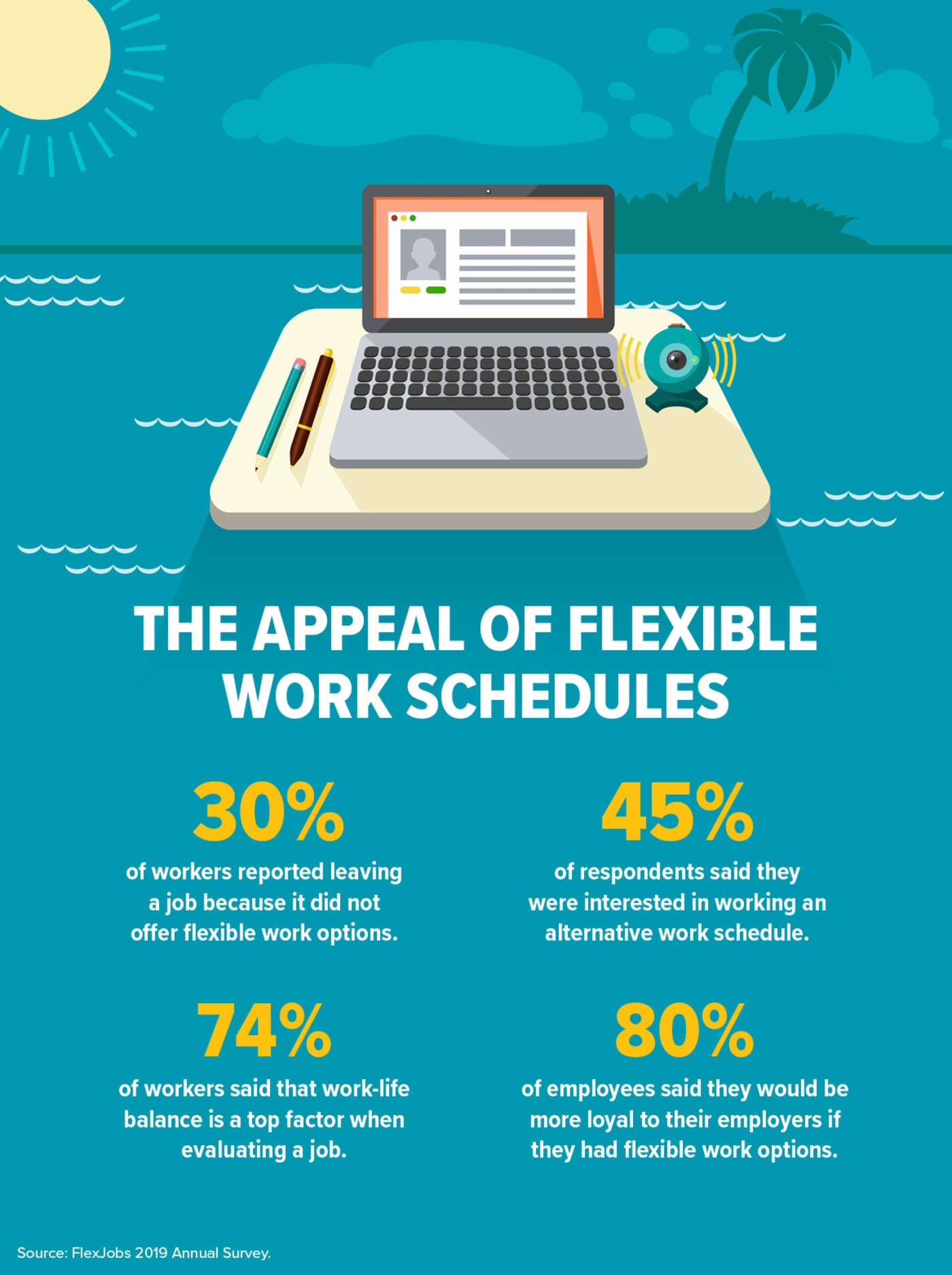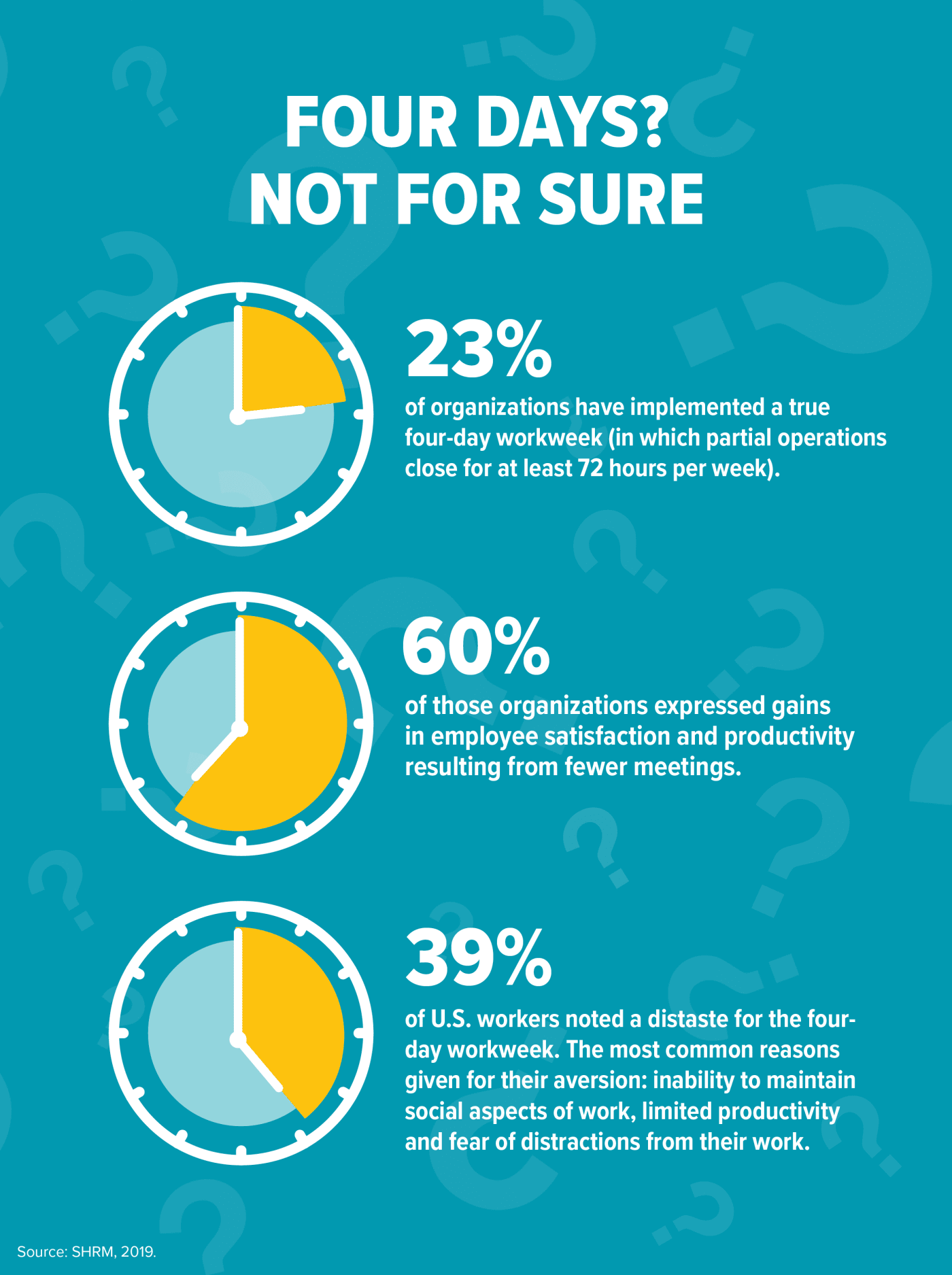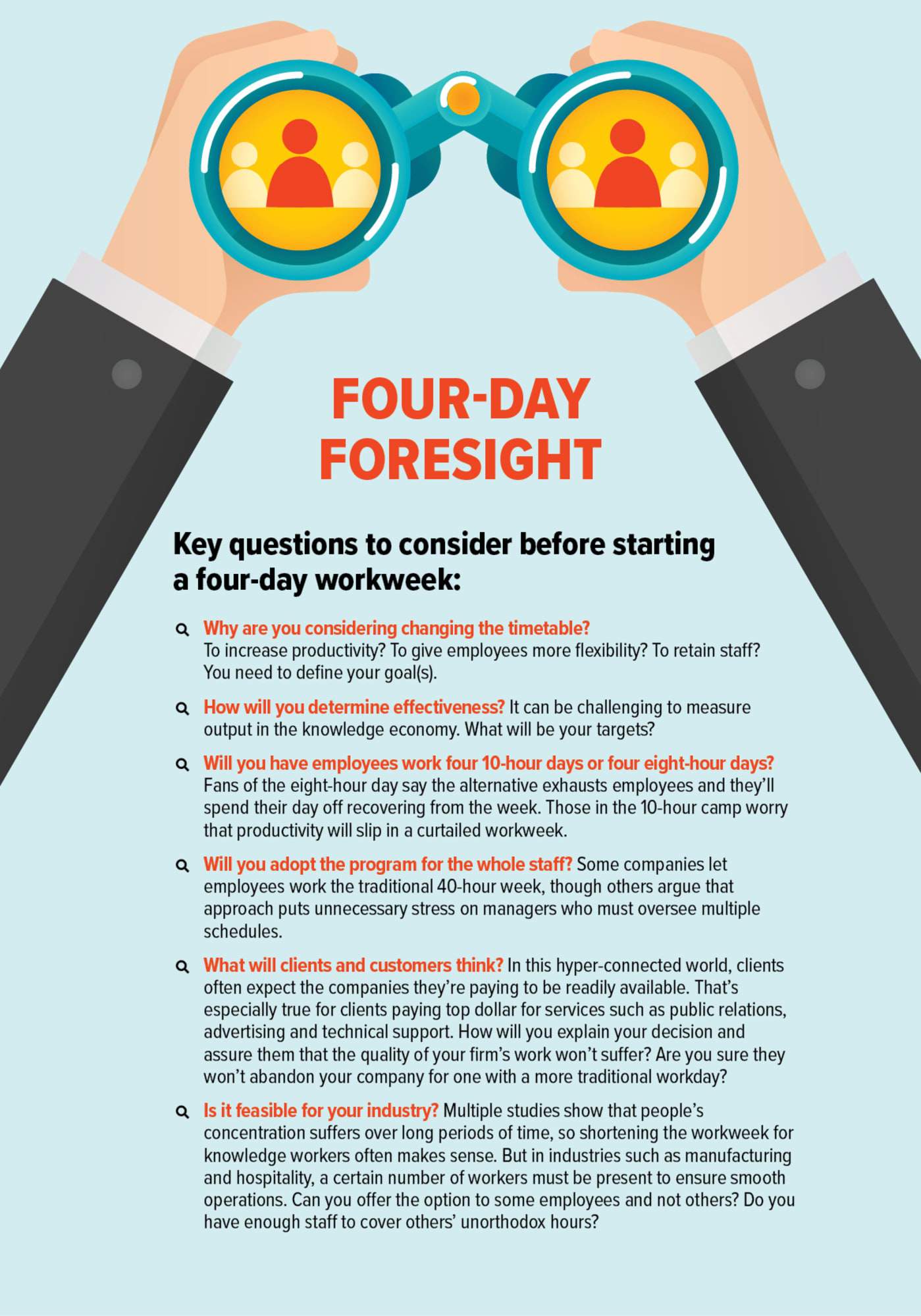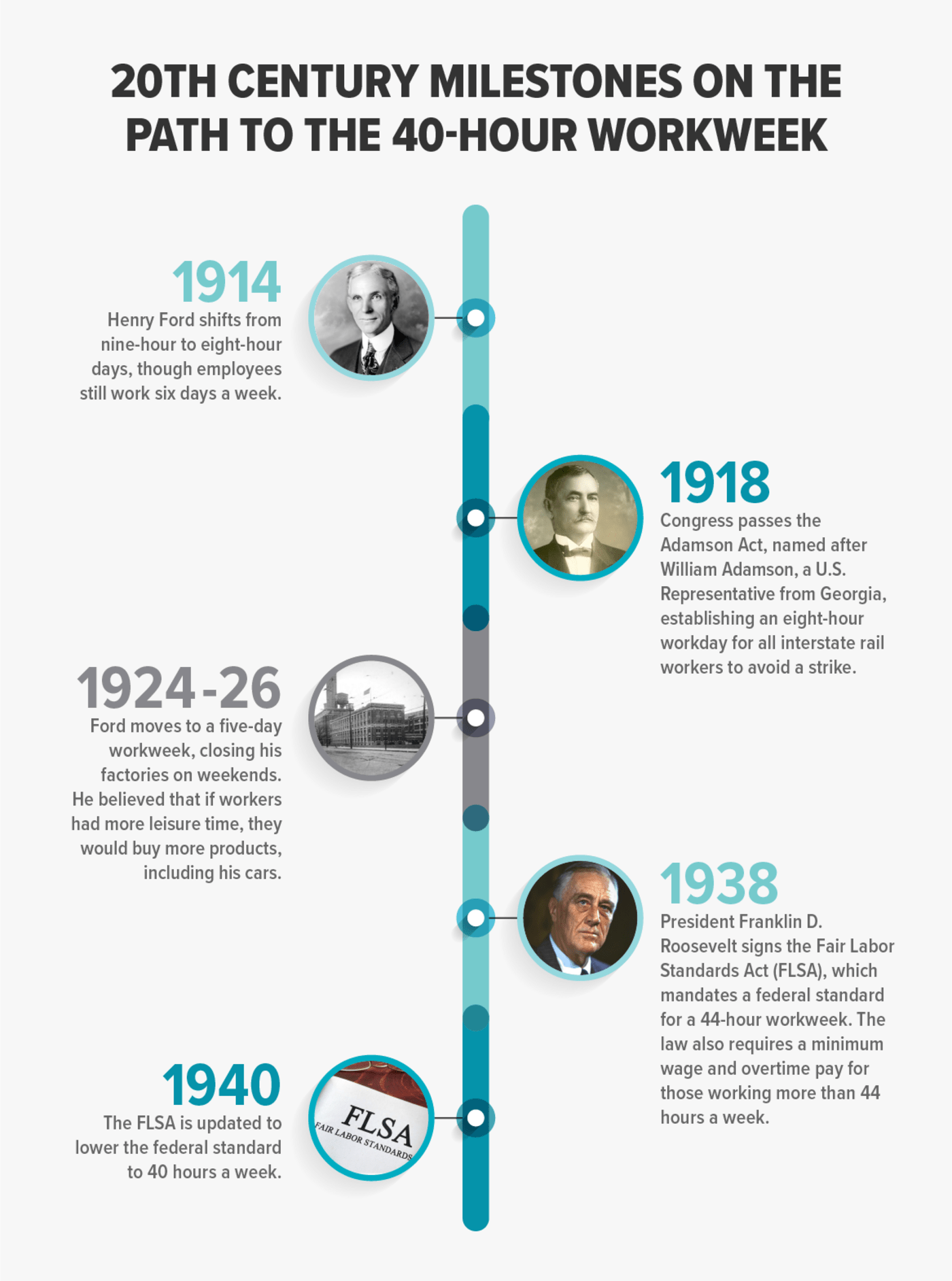Embracing the Four-Day Workweek to Boost Worker Productivity
A shorter workweek could help businesses deal with severe economic and health crises

Before the coronavirus upended the world economy, New Zealander Andrew Barnes was promoting a book he co-authored that extols the benefits of the four-day workweek. The concept had been gathering steam after Barnes' company, Perpetual Guardian, as well as Microsoft Japan, made headlines announcing how such a schedule boosted productivity and increased employee satisfaction. Employers in a tight war for talent paid attention—until the pandemic and subsequent recession changed the conversation.
Now the idea is back, though for very different reasons. New Zealand Prime Minister Jacinda Ardern suggested that a four-day workweek could boost the country's economy. She believes that if individuals use long weekends to visit local spots, the activity could compensate for the lack of foreign travelers in a country that's heavily dependent on tourism. Meanwhile, a group of economists used editorials in papers such as The New York Times to promote the idea of using the four-day workweek to reopen the economy. They proposed that after working for four days, people should quarantine for 10 days, thereby providing people with at least part-time employment and giving any coronavirus symptoms time to become apparent before they return to work. This way, individuals could earn a living while lowering the chance of transmitting the virus.
Some employers are using the four-day workweek as a cost-saving device. In May, journalists at the Los Angeles Times agreed to such a plan, with a commensurate 20 percent reduction in pay for three months to save money for the struggling paper. Stanley Black & Decker also cut some workers' schedules to four days as part of overall cost-saving efforts, which also included salary cuts and layoffs at the New Britain, Conn.-based toolmaker.

The pandemic will ultimately push more companies to adopt the abbreviated work schedule, according to Barnes, co-author of The 4 Day Week (Piatkus, 2020) and founder of Perpetual Guardian, which manages trusts, wills and estate planning. He notes that employers were forced to become more adaptable to keep their businesses running amid the outbreak, including allowing individuals to work from home even if company leaders didn't relish the idea. Barnes says having seen that alternative schedules didn't destroy ethics or productivity, these leaders will be more open to new ways of working.
"It will be a progression," he says. "The four-day week is clearly the better way to go."
Barnes decided to try a four-day week at Perpetual Guardian in 2018 after reading an article in The Economist that said office workers were only productive about two hours a day. "People aren't cognizant of how much time is wasted during the day," he says.
Companies have been slow to adopt new schedules in the U.S., where the five-day, 40-hour workweek is a nearly century-old tradition. Some attempts have been unsuccessful, and instituting such a change could be difficult in industries such as hospitality and retail. But four-day pioneers say the system has been effective, and experts predict that more companies will jump on board to keep flexibility-loving Millennials and Generation Z employees happy.

Unlocking Employee Potential with a Four-Day Workweek
Killer Visual Strategies, a Seattle-based communications agency, put an unorthodox twist on solving the common business challenge of employee fatigue resulting from a company growth spurt. Yes, it hired extra staff, but it also cut the workweek to four days.
"We saw people expressing signs of burnout," says Josh Miles, the agency's president and chief creative officer. "We want to make sure we're taking care of our employees mentally and physically. The four-day week gives people more time to decompress. They come back to work more refreshed."
The change, which was introduced in 2017, had an unexpected benefit. Productivity increased by roughly 20 percent. "That wasn't our goal," says Miles, adding that retention also got a boost. "We just wanted to retain employees and minimize burnout."
The shortened schedule also was a boon during the pandemic. "Our four-day workweek better equipped us for the abrupt shift to fully remote work as our team has years of experience with a flexible work situation and, as such, are quite capable of doing their work from home," he says. "It took our business one, maybe two days to feel fully confident in our transition to an entirely remote work environment."
Creating work environments where employees are healthy, loyal and productive may be the ultimate corporate hat trick. Any strategy that comes even close to achieving that lofty goal is bound to attract attention. Microsoft Japan's announcement last year that employee productivity rose 40 percent during a test of a four-day week grabbed headlines around the world. Interest picked up again at the end of last year when speculation abounded that Finland's newly elected prime minister, Sanna Marin, would institute a nationwide abbreviated workweek in the Scandinavian country.

An increasing understanding of how stress can negatively affect workers' health and productivity is another reason employers may be open to exploring the four-day option. Millennials' desire for more-flexible schedules is also a factor. And employers that take the plunge may find that the four-day workweek improves the bottom line. Companies that used such a schedule saved a total of 92 billion pounds ($120 billion) as operating costs dropped, absenteeism fell and productivity rose, according to a 2019 study of 500 British business leaders by the Henley Business School at the University of Reading in England.
The Eight-Hour Myth
Employers often bog down staff with unnecessary e-mails and meetings that keep them from accomplishing strategic goals. For example, employees spend 1 1/2 hours a day dealing with e-mails. Workers also have their own ways to drain the day. Their two biggest time-stealing activities are checking social media and reading news online, which take up about two hours per day, according to a study conducted in 2017 by Vouchercloud.com, a British discount shopping site. It found that employees are productive, on average, for two hours and 23 minutes a day. Barnes says his employees greatly reduced their time-wasting activities at work when given the option of working fewer hours, which boosted overall productivity significantly.
Considering the two greatest time-sucking options weren't even available when the 40-hour workweek was started nearly 100 years ago, it's easy to see why some companies may abandon the practice. In 1924, automotive tycoon Henry Ford adopted a 40-hour workweek because he thought his employees would buy more cars if they had more leisure time. (Many worked 50 hours a week or more previously.) Other employers followed suit, and the eight-hours-a-day, Monday-through-Friday schedule was born.

Much has changed in 96 years, leading many business experts to say it's time to rethink that schedule—at least for employees in the knowledge-based economy. Professionals such as software developers, architects, engineers and physicians rely on deep thinking to carry out their jobs, and experts say it's difficult to maintain such concentration for eight hours a day.
"Forty hours isn't some kind of a natural law," says Natalie Nagele, co-founder and chief executive officer of Wildbit, a virtual software company where employees work a four-day, 32-hour week. "I don't think 40-hour weeks are productive. Give employees space to do their work. Don't micromanage them. Don't harass them. Don't make them go to unnecessary meetings. They'll get more done in four hours than eight."
Still, it's difficult for companies to leave behind such an ingrained part of American culture. After World War II, the economy blossomed. Purchasing power became a status symbol, and men began to identify themselves with their jobs more than before, says Benjamin Hunnicutt, a professor at the University of Iowa who studies work and leisure time. "Work became the center of male identity," says the author of the recently released The Age of Experiences: Harnessing Happiness to Build a New Economy (Temple University Press, 2020). "We went from working to live to living to work."
As women entered the workforce in greater numbers, they also labored for long hours to prove they were as ambitious and capable as men. Both genders believed that becoming part of the office furniture would save them from layoffs when companies were forced to cut back.
Old Habits Die Hard
Some companies compress the standard 40 hours of work into four days, while others simply lop off one day and require four eight-hour days, usually with no cut in pay. Only 15 percent of U.S. organizations offer four-day workweeks of 32 hours or less to all employees for all or part of the year, according to a 2019 employee benefits report by the Society for Human Resource Management.
There are numerous reasons employers may want to consider the concept. For example, they are paying far more attention to employees' mental health than ever before and understand the importance of giving workers enough time to relax. A study of 1,500 employees by San Francisco-based nonprofit Mind Share Partners found that 60 percent of respondents said their productivity at work was affected by their mental health, and more than one-third thought their work or workplace environment contributed to their symptoms.
Millennials, now the largest generational sector in the workforce, say a flexible schedule is very important to them. In fact, 22 percent say they want to leave their jobs soon because of a lack of work/life balance, according to a 2019 survey by Deloitte.
"The Millennial generation seems to have a different set of values," Hunnicutt says. "We're moving to a post-material economy. People value intangible experiences more than things, and they need time for the experiences." Generation Z employees, who are just starting to enter the workplace, are equally interested in more-flexible work schedules, research shows.
Many companies are experimenting with different kinds of flexible options, such as a condensed workday and telecommuting, to give employees more free time. Nagele says shortened days would pose challenges for her firm because employees work in different time zones and there wouldn't be enough overlap among them for collaboration. Others say the prospect of a three-day weekend is especially attractive to employees.
"Giving people a day off is a massive incentive for them to be more productive," Barnes says.
The Leap to a Four-Day Week
That's what the co-founders of The Slumber Yard believed when they piloted a four-day, 40-hour workweek for two months in 2018. "The staff was initially super-excited," says Matt Ross, co-founder and chief operating officer of the Las Vegas-based company that reviews mattresses. "We thought we hit a home run."
After the novelty wore off, however, employees spent the first 45 minutes of the day chatting, reading the news and eating breakfast. By the end of eight hours, Internet surfing had spiked. And to make matters worse, employees' increased time at the office pushed the business's food budget up by $450 a month—a big tab for a company of 12 people. Productivity fell, and the plan was abandoned.
Ross says he didn't anticipate that employees would work for 10 straight hours. "We don't expect that in an eight-hour day—we have a pool table, a pingpong table, snacks," he says. "We know people need a break. There was just too much Web-surfing and coffee breaks."
Miles, meanwhile, says having employees work four 10-hour days has been a success for Killer Visual Strategies and that the key is letting employees determine their schedules and work locations. He notes that some will work from home for a few hours in the morning and maybe put in some evening time in the office. "We leave it up to the individuals to plan out their days however they see fit, with the caveat that they need to always be reachable via in person, phone or e-mail and that no deadlines are missed," he says.
Killer Visual Strategies is open five days a week, with some staff taking Mondays off and others taking Fridays off, so there's always someone in the office to address client needs. The three days when everyone works leave ample time for meetings and coordination among employees.
"There's no handbook on this," Miles says. "Every company has to figure it out for themselves."
At Wildbit, everyone takes Fridays off except for the six members of the billing and tech support team, who alternate between Mondays and Fridays. This way, someone is always on call. Two weeks every quarter are reserved for planning so employees know what's expected and when assignments are due.
"Employees have to be more intentional on how they spend their time," Nagele says, adding that new employees can be suspect of the arrangement. "I have to be the cheerleader," she says, "and say, 'Yes you can do this.' "
Explore Further
Toolkit: Managing Flexible Work Arrangements



